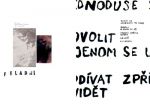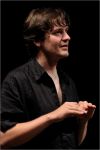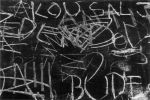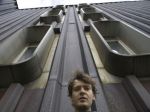English
Jaromír Typlt
 (1973) comes from Nová Paka. He has graduated at Faculty of Arts, Karlova University, Prague. At present he applies himself to exhibitions of progressive art and photography.
(1973) comes from Nová Paka. He has graduated at Faculty of Arts, Karlova University, Prague. At present he applies himself to exhibitions of progressive art and photography.
He has published poetry and prose and in the latest years he gave effect to the book-objects in conjunction with other allied artists.
His text became a part of the short film (Viktor Kopasz: Shadowplay, 2002; Vineyard, 2012) also a radio composition (Michal Rataj: že ne zas až, 2006) and several exhibitions.
 Jaromír Typlt also acts as an editor of fine art and literaty "art brut" (Zdeněk Košek, Hana Fousková, František Novák).
Jaromír Typlt also acts as an editor of fine art and literaty "art brut" (Zdeněk Košek, Hana Fousková, František Novák).
He has also published a number of studies about Czech writers and fine artists in magazines.
Since 1999 he has amplified the form of so-called "mutated authorial reading" in which he makes use of pre-recorded voices, language rhythm but also even the found objects and scenic action in the space.
He was awarted the prize of Jiří Orten in 1994.
He lives in Prague and Nová Paka.
(See only with 3D glasses, or find here 2D version.)
Performancies on YouTube
Škrábanice/Scribble (with Michal Rataj, 2009) – Ursonate (with Pavel Novotný, 2008)
About his work
In the early nineties, Jaromír Typlt presented himself in the context of Czech literature as one of the most distinctive authors of the young generation particularly through his poetic works and numerous essays and literary-critical writings. In his beginnings, he was influenced by the self-destructive poetics of rock music as well as by the growing inspiration by surrealism (cf. Typlt’s first work, “heavy-metal mass composition in F minor” Koncerto grosso / Concerto Grosso, 1990).
Typlt perceived poetry namely as a counterpoint to dull routine and utilitarianism. His creative self-consciousness was pervaded with his desire for constant verbal and sensational initiation and for emotional suggestion, which, nevertheless, time to time materialized in the shape of mannerist gestures. Also Typlt’s prosaic (Pohyblivé prahy chrámů / Movable Thresholds of Temples, 1991, Zápas s rodokmenem / Fighting the Family Tree, 1993) and dramatic (Dříve než vzápětí / Earlier than Afterwards, 1994) works were of similar character. With their emphasis put on all-embracing imagination and the play with absurd dimensions of language, Typlt’s writings more and more adopted the shape of a provocative proclamation “à la Dalí”, which is dominated by structure and form.
 The selection of works titled Ztracené peklo / Lost Inferno (1994) represents a sort of programme review of Typlt’s early writings, consisting, among others, of the collections Procitající teurgos / Teurgos Awakening and Epocha Setmění / The Epoch of Nightfall (subtitled Kytaromachie / Guitarmachy). Here, Typlt tried to sketch, through cascades of metaphors, neologisms, and archetypal images, the “new cosmogony”, a sort of poetic universe construed out of defiance, streaming out of the subject himself.
The selection of works titled Ztracené peklo / Lost Inferno (1994) represents a sort of programme review of Typlt’s early writings, consisting, among others, of the collections Procitající teurgos / Teurgos Awakening and Epocha Setmění / The Epoch of Nightfall (subtitled Kytaromachie / Guitarmachy). Here, Typlt tried to sketch, through cascades of metaphors, neologisms, and archetypal images, the “new cosmogony”, a sort of poetic universe construed out of defiance, streaming out of the subject himself.
The postulate of a forced breakthrough into the absolute equilibrium of the creative truth is conveyed by the essayistic manifest titled Rozžhavená kra / Red-Hot Ice Floe (1993/1996), in which Typlt categorically rejects all modern conventions of contemporary art and literature.
After 2000, Typlt has been publishing his own texts only sporadically, mostly in form of bibliophilic prints. In these, the author’s literary expression is closely intertwined with the visual art; the graphic element and the word complement and inspire one another: it is only the moment of their mutual interaction that yields the unity of meaning. Such are the so-called “authorial books”, which Typlt has been creating together with the artist Jan Měřička since 1999. Some of these texts have been collected in the book titled že ne zas až / that-the-un-struck (2003).
It was as late as in 2007 with the publication of the book Stisk / Squeeze (2007) that Typlt re-entered the wider literary communication; with the book representing a varied composition of his poetic, prosaic, and essayist work from the period 1993 – 2007. In these texts, Typlt did manage to manage do without programme accentuations and proclamations of linkage with surrealism. Nevertheless, Typlt has continued to build his style upon expressive creative gesture, experiment, and play. The prosaic texts are governed by strong lyrical elements and experiments with structure and composition. Their thematic level is enfolded in dreamlike indeterminateness, and the logic of narration is penetrated by deliberate absurdity. Also the poetic texts of the collection are playful and experimental; to a large extent building up on the graphic elements of expression; with irrational imagination clashing with constituents of the language of discourse.
Adopted from Slovník českých spisovatelů po roce 1945 / Encyclopaedia of Czech Writers after 1945
Entry authors: Vladimír Novotný and Karel Piorecký
Some poems
That is talk hitting
I lie
at the bottom
of hardly hearable
rattles and thrums.
Hardly hearable,
yet persistent. They push through,
intruding upon me from below,
rubbing off on me, lightly
yet very, very lightly
they
keep hurting.
As if something frayed
between the floor and the ceiling,
somewhere in places where they cannot yet be told apart.
Particularly that high-pitched,
almost clear,
at times intermittent
quiver.
That is talk hitting.
It might be women chatting downstairs.
Translated by Veronika Revická
More poems
Fragment B101 (2011, translated by David Vichnar)
When You (2003, translated by David Vichnar)
More poems – (1990–2007, translated by Veronika Revická) Instinctea, Alive, Lids
More poems 2 (1990–2010, tranlated by David Vichnar) – Defloration, Anxietea, Concertea, In the Sign
A mutated radiophonic reading
I have been trying in various ways since roughly 1999 to find new approaches to the tried-and true - but in my opinion not very interesting - approach to author readings. I started to call my approach "mutated author readings", perhaps in part because it is constantly growing and taking on new, unforeseen forms.
Since the very beginning, I have used computer-altered recordings of myself which have allowed me to agree as well as to disagree with myself, to interrupt myself, to cut myself off, to chime in… Over time, I naturally tried to use this approach to create a final recording. These recordings later formed the basis for creating this mutated radiophonic reading.
More informations – Radiocustica
Photo by Stanislav Chlup, Renata Štěpařová (portraits) and Jaromír Typlt.


